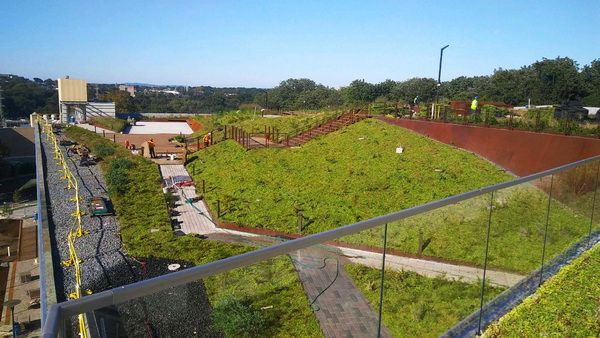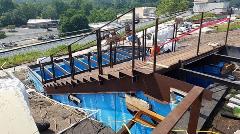
Green roof overview with stairs and vegetation.
On top of a pharmaceutical company’s parking garage in Wilmington, Delaware, there grows a thriving patch of countryside, courtesy of SMACNA member Ernest D. Menold Inc. This unique roof serves as a beautiful reminder of the form and function that can be involved in architectural exteriors. It’s a growing, thriving green roof, yet that lush green roof is also growing energy savings as well.
This particular green roof with meadows, gardens, and walking paths – not your normal fare – was produced by a SMACNA firm. This “field” was created to complement the new 190,000 square-foot corporate headquarters of Incyte Pharmaceuticals. The high-profile eco-roof was the second rooftop project for SMACNA member Ernest D. Menold Inc., who took the lead in bringing the architect's vision to life.

Installing upper staircase with supports below.
“I think the roof looks great,” said Ernest J. Menold, president of the Lester, Pennsylvania-based sheet metal company. “We are very happy with the installation. We solved a lot of the architect’s issues for them and the final result looks incredible.”
The rooftop features a pickleball court, a putting green, a walking trail and community gardens – amenities designed to encourage more interaction among Incyte employees. It's an impressive balance among recreational spaces, pathways and nature. Given the scale of the 154,000-square-foot green roof, it is challenging to visually capture the beauty of the entire finished project.
Ernest D. Menold Inc. fabricated all the edging, stairways and handrails on the roof, while leading the way with the CAD drawings and coordination of all the various trades involved.
“There is a lot of engineering involved in a green roof,” noted Rich Davis, project manager for Ernest D. Menold Inc. “It's not just putting dirt on the roof and growing plants,” he said. It includes multiple layers above a weatherproof membrane and special soil that is infused with air to reduce its density and weight. Much of the Incyte eco-roof included large pieces of block foam as one of the many underlayment layers. All of this serves as additional insulation, while saving energy too.
According to the EPA, the temperature on a green roof is 30 to 40 degrees lower than a conventional roof, which significantly reduces the building's need for air conditioning in the summer. Eco-roofs also reduce water runoff and improve outdoor air quality.
Besides a heavy engineering lift, the rooftop project also called for architectural components using solanum steel, a pre-oxidized weathering steel alloy (also called Corten) developed by another SMACNA member, architectural metalwork company A. Zahner of Kansas City, Missouri.
The steel surface is produced by accelerating the natural weathering process and stabilizing the result. Solanum steel provides long-term endurance and as its surface oxidizes, the oxidized layer becomes a protective layer. It provides the weathered look of steel with warm hues yet will not bleed into adjacent surfaces as regular steel would.
The weathered steel components help add artistic elements of line, shape and color to the Incyte roof landscape, while contrasting beautifully with the natural living features of the roof design.
Greenrise Technologies, a full-service green infrastructure firm, contacted Ernest D. Menold Inc. for the roof project. The scope of their work included fabrication and installation of these architectural elements:
-
A 16-foot high sloped metal wall, along with the 3-inch by 3-inch by ¼-inch HSS (hollow structural section) architectural structure to support it.
-
A ¼-inch thick solanum steel retaining wall.
-
Corten edging on the green roof.
-
A 9,000-pound upper feature staircase.
-
20 feet of solanum steel cabinets for recreational supplies and seat cushions.
“The landscape retaining wall and edging met at all different compound angles, all while keeping the construction without exposed fasteners. It ensured that the finished product was aligned and straight,” Davis said.
“One of the biggest challenges was gaining the trust of the architect, owner and construction management team to allow us to take the lead,” Davis continued. “The frustrating part was waiting for the design team to approve our drawings so we could move forward with the drawing and detailing for fabrication – converting the two-dimensional plan and elevation drawing into a three-dimensional drawing that would work.”
Davis said one of the reasons he believes Ernest D. Menold Inc was given the lead role in the drafting portion of the project was because they use the 3-D software Inventor, an Autodesk product. “We even coordinated the LED lighting bollards (landscape post lighting) on the platform,” he added.
While green roofs have been popular in Europe for decades, the use of this green construction feature wasn't particularly common in the U.S. until relatively recently. Incyte is just one of the big name businesses propelling the eco-roof trend. Facebook, for example, made headlines last year when the company installed a 3.6-acre rooftop garden with trees and pathways on top of its Menlo Park, California headquarters.
Ernest D. Menold Inc. hopes the trend will bring in more green roof work. Davis said working on the Incyte project was fun and the green project attracted a lot of attention. It’s gaining attention from Incyte’s employees too, who stroll along its pathways, practice their putting, and pause for contemplation among its landscaped gardens.